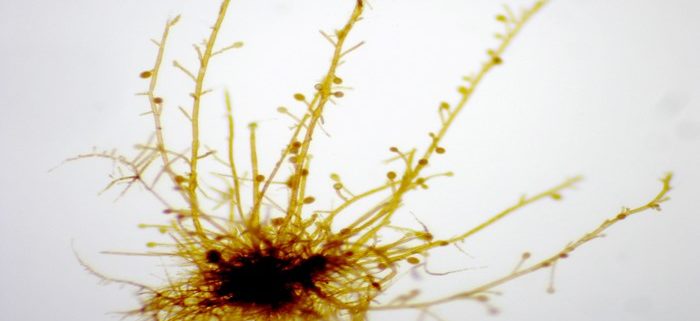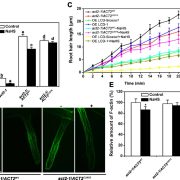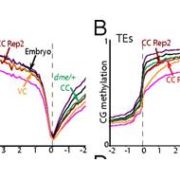HOW TO BUILD A SEAWEED
Godfroy et al investigate basal cell fate determination in the brown alga Ectocarpus https://doi.org/10.1105/tpc.17.00440
BACKGROUND: Brown algae are multicellular photosynthetic marine organisms living on rocky shores across the globe and representing one of the most developmentally complex groups within the eukaryotes. As in many land plants and animals, their main body axis is established early in development, when the initial cell gives rise to two daughter cells that have apical (‘stipe’) and basal (‘holdfast’) identities, analogous to ‘shoot’ and ‘root’ identities in land plants, respectively. The establishment of the apical-basal axis in the model land plant Arabidopsis is controlled by a complex genetic network that is well characterized, but we have remained surprisingly ignorant about the mechanisms and genetic systems that underlie apical-basal axis formation in the brown algae.
QUESTIONS: We wanted to find out how, from a single cell released in the ocean, brown algae initiate the development of their basal system. What are the gene(s) and mechanisms involved in building a seaweed holdfast?
FINDINGS: We used Ectocarpus, a small filamentous brown alga amenable to laboratory techniques, and a range of genetic, cell biology and genomic approaches to identify and characterize a gene (DISTAG/TBCCd1) that controls the position of organelles inside the first cell of the alga, and is required for the initiation of the basal system in this organism. distag mutants therefore allowed us to link subcellular events within the initial cell with apical-basal axis formation and the acquisition of cell identities in Ectocarpus. TBCCd1 proteins are involved in cellular patterning in plants and animals, so our study has also emphasized the remarkable functional conservation of TBCCd1 proteins in regulating internal cell organization across a billion years of eukaryotic evolution.
NEXT STEPS: More work is required to understand the exact cellular role of TBCCd1 in Ectocarpus and other brown alga, and to uncover the detailed mechanisms involved in establishing the basal system identity in these organisms. A comparative analysis of the pathways involved in cell fate determination in brown algae, green plants and animals would provide important information on how these developmental processes are conserved, or not, across different multicellular organisms.
Olivier Godfroy, Toshiki Uji, Chikako Nagasato, Agnieszka P Lipinska, Delphine Scornet, Akira F. Peters, Komlan Avia, Sebastien Colin, Mignerot Laure, Taizo Motomura, J. Mark Cock, Susana M. Coelho. (2017). DISTAG/TBCCd1 Is Required for Basal Cell Fate Determination in Ectocarpus. Plant Cell. Published December 2017. DOI: https://doi.org/10.1105/tpc.17.00440










